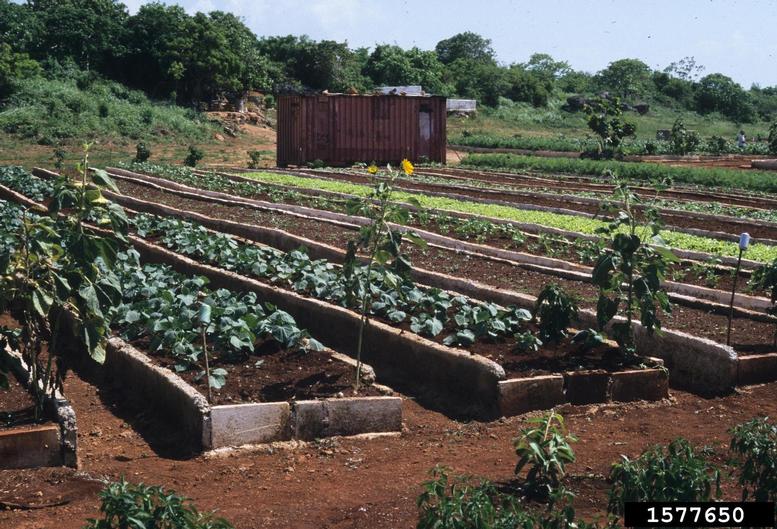 Soil Tips for Raised Beds - April 25, 2018 Jeff Schalau, Agent, Agriculture & Natural Resources University of Arizona Cooperative Extension, Yavapai County Many Northern Arizona gardeners use raised beds and large containers to grow annual crops such as flowers and vegetables. Most people do this because arable soil on their property may be shallow, rocky or nonexistent. Raised beds have many other advantages: convenience, accessibility, improved drainage, ease of frost and pest protection, weed management, and more. A major disadvantage in some raised bed gardens is limited space making it difficult to rotate crops. Crop rotation is critical in maintaining productive, disease-free garden plants. Most raised bed gardeners want to grow tomatoes and peppers which are both in the Nightshade Family (Solanaceae) often growing them in the same bed in successive years. Many disease organisms are soil-borne and can persist in the soil. Disease problems usually increase when the same “plant family” is planted in the same area in successive years. Similarly, insect problems can become more severe when crop rotation is not practiced. Raised bed gardeners often have limited space for crop rotation. In addition, they may have filled their raised beds with bagged, artificial soil media (potting soil). Cooperative Extension help desks receive many calls each year from clients describing how their raised bed garden has become less productive after two growing seasons. After questioning these clients, invariably their raised beds were filled with artificial soil media and they have not practiced crop rotation. Artificial soil media is widely sold for potted plants and seed starting. It is also popular with people that have “container gardens”: pots or larger containers such as half barrels and livestock watering troughs. Artificial soil media contains no mineral soil. It is usually a combination of peat, perlite, bark, coir (ground coconut hulls), and a small amount of inorganic fertilizer. In recent years, water-holding, hydrogels are also added to commercially available artificial media. Artificial media works well for potted plants and seedling transplants. However, when used in raised beds, disease organisms build up and fertility declines when used for more than one season. Container gardeners are always more successful when artificial soil media is replaced each year. The spent media can be composted where beneficial microorganisms in the compost pile can colonize it and break it down further. Getting back to soil material, I feel that mineral topsoil is most desirable media for raised bed gardening. Mineral topsoil consists of sand, silt, clay, and locally-adapted beneficial soil microorganisms. Ideally, the soil is gleaned from other areas of your property and is free of weed seeds and other propagules (perennial weed rhizomes). Rocks and gravel should also be screened out before placing it in the raised bed. If soil is not available on your property, seek out vendors that provide non-amended topsoil so you have the freedom to select amendments used. Local mineral topsoil should also contain locally-adapted beneficial soil microbes including mycorrhizae (beneficial fungi), bacteria, and protozoa. Compost, alfalfa meal/pellets, and other organic amendments can be added to create a productive, resilient garden soil. Pre-amended “topsoils” sold by some vendors contain coarse woody debris which is resistant to decomposition and horse/steer manures which contain concentrated salts from saturation with animal urine. Cooperative Extension has measured the salinity (salt content) of several amended topsoils and found many of them to usually be high. Leaching with water can lower the salinity, but why not avoid unnecessary work and water use. Use non-amended topsoil, preferably with a loamy soil texture (a balanced mixture of sand, silt and clay). Soil texture can be approximated by anyone willing to get their hands dirty (protocol included with the online edition – see URL below). Purchasing mineral topsoil will involve some labor to transport the soil from where it was delivered to the location of your raised bed. Mineral topsoil will provide a sustainable, productive substrate for your gardening endeavors. It can be further enhanced by growing cover crops and minimizing tillage to develop robust, locally-adapted soil microfauna. I have included several more detailed references with the online edition for those wanting additional information. Here are a few additional recommendations for raised bed gardeners to consider: build additional beds if space is too limited to rotate crops; install hardware cloth deep under beds to deter pocket gophers; build low tunnels to facilitate winter gardening; develop compost processes/resources that support your raised bed; and have enjoy the healthy food harvested from you raised beds! Follow the Backyard Gardener on Twitter – use the link on the BYG website. If you have other gardening questions, call the Master Gardener help line in the Camp Verde office at 928-554-8992 or e-mail us at verdevalleymg@gmail.com and be sure to include your name, address and phone number. Find past Backyard Gardener columns or provide feedback at the Backyard Gardener web site: http://cals.arizona.edu/yavapai/anr/hort/byg/. Photos  Raised beds at Cal Poly, San Luis Obispo showing various crops (Gerald Holmes, California Polytechnic State University at San Luis Obispo, Bugwood.org).
Raised beds at Cal Poly, San Luis Obispo showing various crops (Gerald Holmes, California Polytechnic State University at San Luis Obispo, Bugwood.org).Additional Resources Determining Soil Texture by Feel University of Kentucky Cooperative Extension Service uknowledge.uky.edu/cgi/viewcontent.cgi?article=1139&context=anr_reports Raised Bed Gardening Oregon State University Extension Service catalog.extension.oregonstate.edu/sites/catalog/files/project/pdf/fs270_1.pdf Container and Raised-Bed Gardening Virginia Coopertive Extension pubs.ext.vt.edu/content/dam/pubs_ext_vt_edu/426/426-020/426-020_pdf.pdf Crop Rotation in the Vegetable Garden Iowa State University Extension and Outreach hortnews.extension.iastate.edu/1998/3-27-1998/rotateg.html Sustainable Management of Soil-borne Plant Diseases ATTRA Sustainable Agriculture attra.ncat.org/attra-pub/viewhtml.php?id=283#general_suppression |